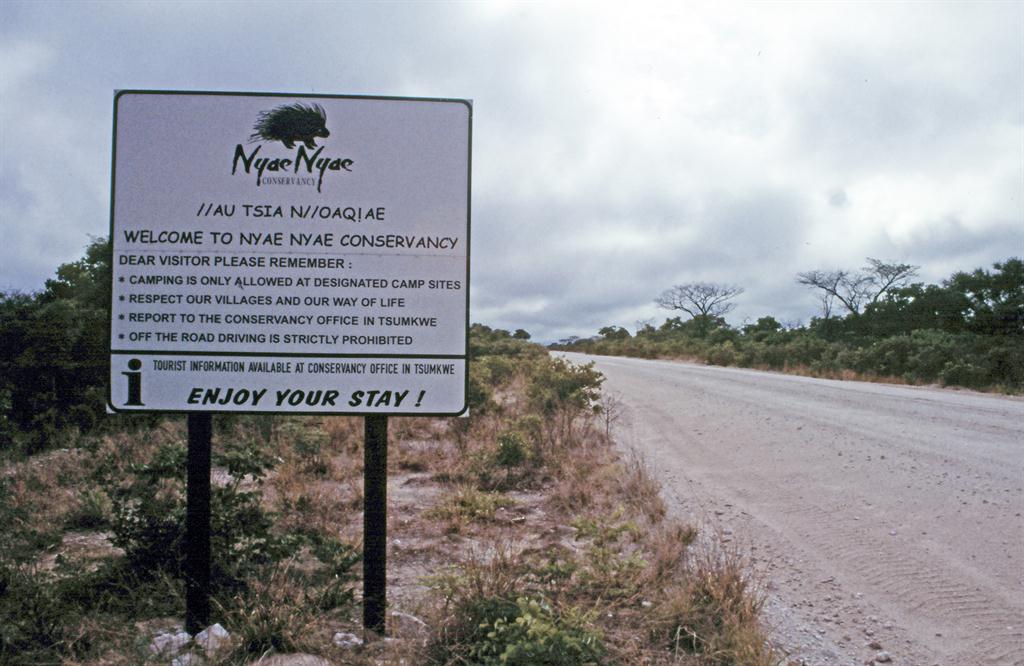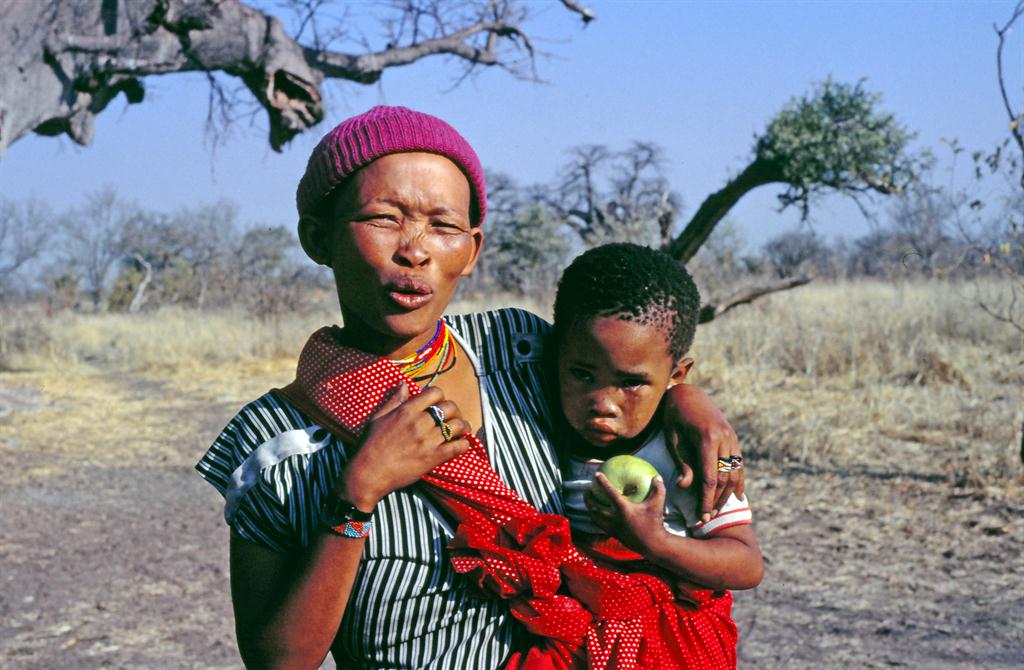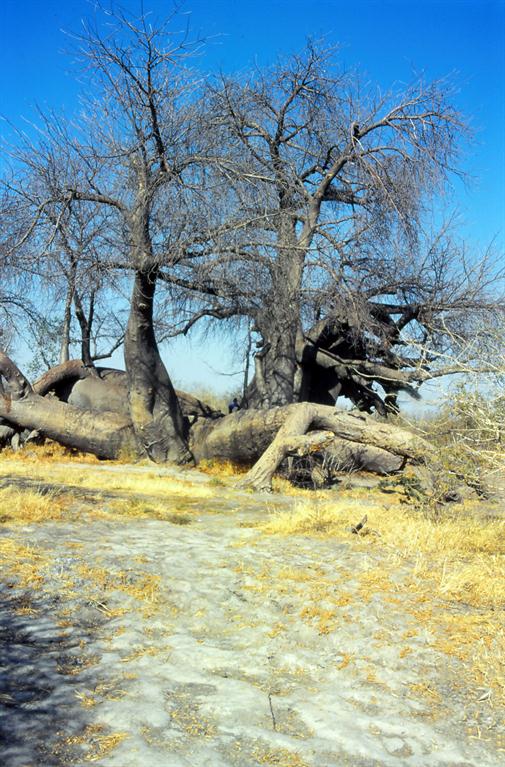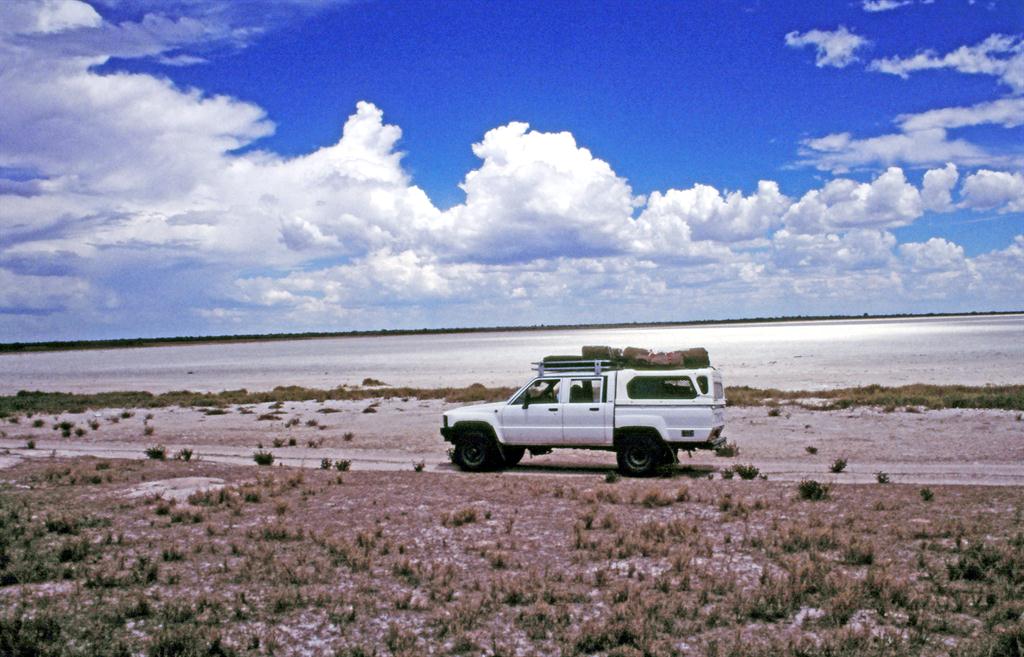DEAD AND ALIVE
The Dorslandtrek Baobab owes its name to the Dorslandtrekkers (Thirstland Trekkers) who camped here in the late 1800s during their epic journey from what was then known as the Transvaal (the current Northwest Province of South Africa) to Angola. It has also been referred to as the Sewestam Kremetart (Seven-trunk Baobab), but since the largest trunk consisted of two fused trunks, Eight-trunk Baobab would have been a more accurate name. Two trunks collapsed before 1880, but continued living, while the oldest two trunks of this giant, which is between 1 915 and 2 100 years old, toppled and died in 2006.
THE FIRST PEOPLE
The Nyae Nyae Conservancy forms part of the ancestral home of the Ju/'hoansi (San) who have lived here for thousands of years. Their territory once stretched from Rundu southwards to the Eiseb Omuramba, eastwards across the Aha Mountains into Botswana as far as Lake Ngami and from there in a northwesterly direction to the Okavango River. They live in 30-odd settlements scattered throughout the conservancy. Theirs is a society in transition and although hunting and gathering still play an important role in their lifestyle, they also keep small numbers of livestock and plant crops during the rainy season, while crafts and tourism are other sources of income.
DEMISE OF THE GIANTS
Two of the well-known Baobabs in the Nyae Nyae Conservancy have collapsed in recent years. The demise of the Grootboom, which towered 32 m above the landscape and had a circumference of 30.6 m, began in late 2004 and the last trunk fell at the end of December 2004/early January 2005. The Holboom, which had a circumference of 35.1 m and a height of 30.2 m, owed its name to the huge cavity in its trunk. Several trunks and cavity walls began breaking off since 2012 and the tree finally collapsed earlier this year. Scientists have suggested that the death and partial collapse of nine of southern Africa’s large Baobab trees could be due to climate change.
NAMIBIA’S FIRST COMMUNAL CONSERVANCY
The Nyae Nyae Conservancy was the first communal conservancy to be established in Namibia in February 1998. Its Ju/'hoan name means ‘place of broken rocks,’ a possible reference to the calcrete rocks that crop out in the east of the conservancy. The antelope populations that occurred in the area prior to the conservancy’s establishment were boosted with the release of 2 200 animals of six species between 1999 and 2005 and wildlife numbers have increased steadily.
EPHEMERAL WETLANDS
The seasonally inundated wetlands of the Nyae Nyae area are recognised as an Important Birding Area of global significance. These wetlands attract up to 10 000 wetland birds of 84 species during favourable conditions, including thousands of Greater and Lesser Flamingos. The pans are also an important habitat for breeding Slaty Egret and Great Snipe, as well as the endangered Wattled Crane.
The Dorslandtrek Baobab owes its name to the Dorslandtrekkers (Thirstland Trekkers) who camped here in the late 1800s during their epic journey from what was then known as the Transvaal (the current Northwest Province of South Africa) to Angola. It has also been referred to as the Sewestam Kremetart (Seven-trunk Baobab), but since the largest trunk consisted of two fused trunks, Eight-trunk Baobab would have been a more accurate name. Two trunks collapsed before 1880, but continued living, while the oldest two trunks of this giant, which is between 1 915 and 2 100 years old, toppled and died in 2006.
THE FIRST PEOPLE
The Nyae Nyae Conservancy forms part of the ancestral home of the Ju/'hoansi (San) who have lived here for thousands of years. Their territory once stretched from Rundu southwards to the Eiseb Omuramba, eastwards across the Aha Mountains into Botswana as far as Lake Ngami and from there in a northwesterly direction to the Okavango River. They live in 30-odd settlements scattered throughout the conservancy. Theirs is a society in transition and although hunting and gathering still play an important role in their lifestyle, they also keep small numbers of livestock and plant crops during the rainy season, while crafts and tourism are other sources of income.
DEMISE OF THE GIANTS
Two of the well-known Baobabs in the Nyae Nyae Conservancy have collapsed in recent years. The demise of the Grootboom, which towered 32 m above the landscape and had a circumference of 30.6 m, began in late 2004 and the last trunk fell at the end of December 2004/early January 2005. The Holboom, which had a circumference of 35.1 m and a height of 30.2 m, owed its name to the huge cavity in its trunk. Several trunks and cavity walls began breaking off since 2012 and the tree finally collapsed earlier this year. Scientists have suggested that the death and partial collapse of nine of southern Africa’s large Baobab trees could be due to climate change.
NAMIBIA’S FIRST COMMUNAL CONSERVANCY
The Nyae Nyae Conservancy was the first communal conservancy to be established in Namibia in February 1998. Its Ju/'hoan name means ‘place of broken rocks,’ a possible reference to the calcrete rocks that crop out in the east of the conservancy. The antelope populations that occurred in the area prior to the conservancy’s establishment were boosted with the release of 2 200 animals of six species between 1999 and 2005 and wildlife numbers have increased steadily.
EPHEMERAL WETLANDS
The seasonally inundated wetlands of the Nyae Nyae area are recognised as an Important Birding Area of global significance. These wetlands attract up to 10 000 wetland birds of 84 species during favourable conditions, including thousands of Greater and Lesser Flamingos. The pans are also an important habitat for breeding Slaty Egret and Great Snipe, as well as the endangered Wattled Crane.









